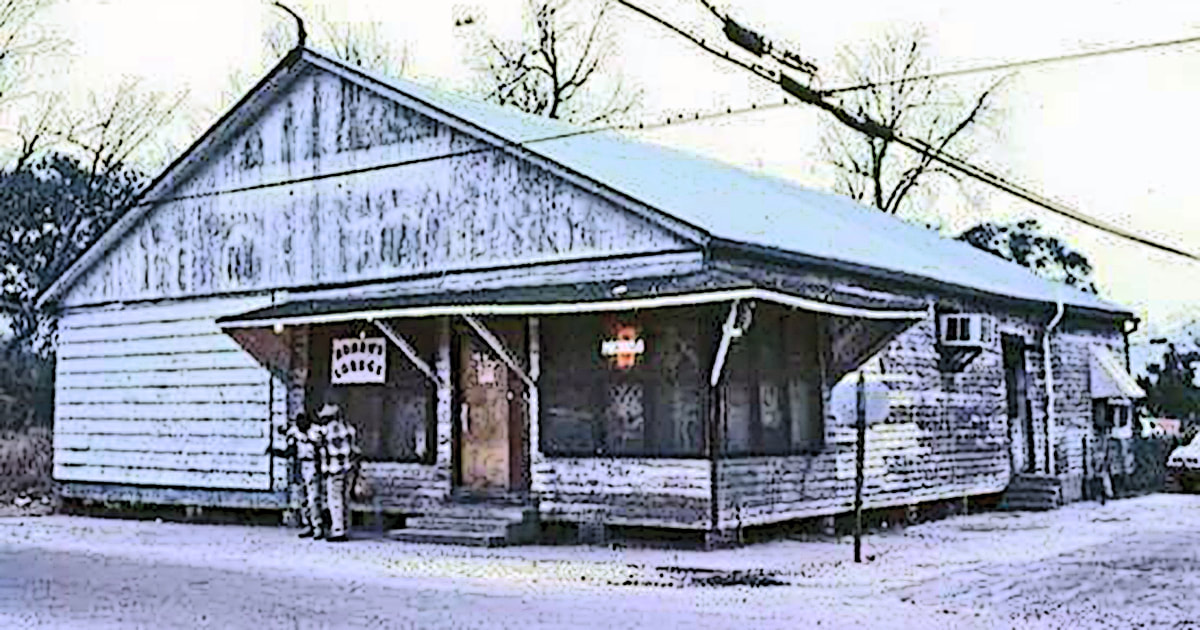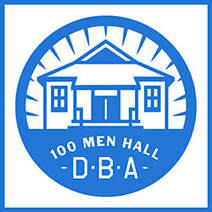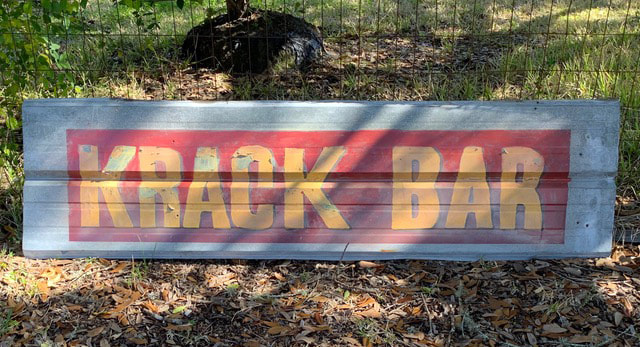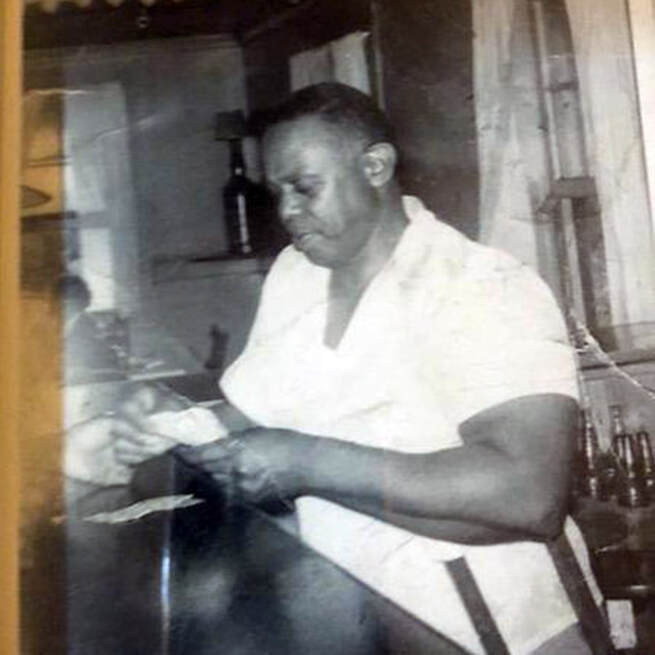Sycamore Street, formerly home to several popular juke joints, used to hum with music and good times. Take a spin around the dance floor in this look back in time.
- Story by Rachel Dangermond
The juke joints began opening in the late 1930s and early ’40s against a backdrop of segregation and Jim Crow laws. For African-Americans, there were no public spaces other than church to socialize and celebrate, except the ones they created.
Here in Bay Saint Louis there were dozens of these bars, but at the top of everyone’s list was the Krack Bar & Lounge, owned and operated by Floyd Moseley, Sr. and his family for an extended period of time. The Krack Bar & Lounge
Claudette Henley remembers that her grandmother owned the property and her dad turned it into a bar a few years after marrying her mother (1935). Her younger brother, Floyd “Martin” Moseley, Jr., worked alongside his father. “My dad couldn’t read or write, but he could count money,” said Martin. The building was one large room, and it had a small crack where you could see inside, hence the name. Over time, the Krack grew to have a restaurant on one side and a pool hall on the other.
In the black community, the Krack was the place where you started and where you ended.
“The Krack never closed,” said Golden Fairconnetue, whose mother ran a restaurant on Sycamore Street . “No matter where you went, you always wound up back at the Krack.” According to Calvin Smith, whose grandfather Oswald Gilbert took over after Floyd retired, the Krack was known far and wide and frequented by many people from New Orleans and along the Gulf Coast. “It had an aura that attracted many customers who liked the atmosphere. Good music, good food and beer by the barrel flowed from behind the bar there,” said Smith. Blanche Godfrey operated the restaurant and served memorable hamburgers and fries to adults and kids. Oswald Gilbert ran the bar until his death in 1957, and then his son, Anthony, better known as “Gil,” took over. Although Hurricane Camille ravaged the area in 1969, the Krack withstood, and after being patched together with tin, it reopened to a welcoming crowd. The Krack was an ongoing institution until Hurricane Katrina devastated it in 2005. The Big 5 Club
The Big 5 Club, at 437 Sycamore Street, opened in the ’50s and was owned for a decade by Nathan “Sweetie” Little with Thomas Lahland. The bartender was James Smith.
“James worked for Mr. Mark, a white guy, servicing pool tables, juke music boxes, and vending machines. This gentlemen helped James purchase the building in the 1960s,” said James’s wife, Pinky Lee. The Big 5 was open seven days a week, and on most weekends didn’t close until way after the sunrise. According to Pinky, James would get a couple hours of sleep and open right back up. The bar sold pig's feet, pig lips and hot links with crackers. The choice of beer was Schlitz, Falstaff and Miller High Life ponies, and Miller Lite. You could always bring in your own half-pint of hard liquor and purchase a setup, which was two Cokes or 7Ups with a bowl of ice. Two years after James’s death in 1996, Pinky Lee sold the property to Jordan Bush, who eventually made it a church. Mama Harriet's Snack and Bar
Also in the ’50s, Mama Harriet’s Snack and Bar opened at 435 Sycamore Street. Mama Harriet mainly ran a rooming house for men who worked on the railroad. Business was good, so she soon added a bar, restaurant, and sweet shop. Children were not allowed inside but instead went to a window to buy candy, chips, drinks and homemade freeze pops.
After Mama Harriet lost her eyesight, her daughter-in-law, Olivia, ran the window. When her son, Clarence, and Olivia both passed away, Clarence’s daughter, Ann Evans, came home from New York and renamed it Tavern on the Green, which was short lived due to her health. The place sat abandoned until Hurricane Katrina destroyed it. The Onion
Social life flourished along Sycamore Street and the surrounding neighborhood for African-Americans, and many more juke joints opened. The Onion was soon another hotspot in the area. It was owned by Frank Lewis, who operated three clubs: Lewis’s Bar on St. Frances Street in the ’50s, the Big Four in Waveland, and the Onion, which opened in the ’60s.
“My dad really loved his businesses because he wanted to socialize and be among his friends,” say Lewis's daughter, Ollie Mae Lewis. In the ’70s, the Onion changed its name to the Red Machine Lounge, and Ollie and her sister, Rose, took over the management. These bars provided places for the African-American community to gather, socialize, and enjoy themselves. The businesses also served the black community's need to engage in activities that were otherwise closed off to black people. According to Calvin, the Krack sponsored an adult football team called the Bay Wildcats that played against other black teams from along the coast, New Orleans, and Mobile. “Patrons flocked to the bars before and after the basketball and football games. Football was played on the St. Stanislaus athletic field and basketball at the St. Rose de Lima gymnasium (aka the 'Cracker Box').” The Big 5 sponsored a baseball team and the Onion sponsored the Red Machine, a softball team. The Connection
On the corner of St. Francis and Sycamore Streets sat the Connection, a home turned into a bar by Willie C. Acker (aka "the Poor Slave"). Willie was a schoolteacher, and his wife, Eartha, ran the club. Willie wanted a place where people could meet and connect by having a cold beer, listening to good music, and enjoying friendship. On any given Saturday at the Connection, you could throw a game of horse shoes and have a plate of good, fresh fish straight off the grill.
Bobby's Lounge
Nearby on Sycamore, Daisy Bell bought the former Sam Compretto’s grocery store with the dream of opening a restaurant and bar, which she intended to call Bell’s Restaurant and Lounge. Her children were going to run the business, but her son, Sullivan, took a job with MAPP Head Start and soon became the regional director in Picayune. Her other son, Sterling, pursued his own dream to be an electrician at Ingalls Shipyard, where he became electrical supervisor, so her daughter, Sharon, and her husband, Bobby McGown, took over, and the name became Bobby’s Lounge instead.
Bobby’s favorite line was, “Juke right now only if you are ready,” which earned him the nickname “Juke.” Bobby’s Lounge became the club of the ’80s, where young people felt right at home. The beers of choice were Miller Ponies, Miller lite, Bud and Bud Lite, Heineken and Corona. A host of birthday parties were held there, as was a big New Year’s Eve party every year. The club was later renamed M.C.M. (Making Cash Money). The Ice House/Lyons Den
In the early ’60s, Harry Leroy Lyons (aka "the Greedy Man") turned the old Ice House, at 308 Blaize Avenue, into a bar by the same name. His idea was to have a good time with drinking, dancing and some gambling in the back.
His customers favored Jax, Dixie, Schlitz and Falstaff beers, along with some homemade moonshine. There was a jukebox where for 25 cents you could play three songs. They would listen to music by Al Green, Otis Redding, Mary Wells, Marvin Gaye, Etta James, Ray Charles, Diana Ross and so many other legends of the era. “If only the walls could talk, they would have a lot to say,” his daughter, Dianne Lyons, said. The adult bar was upstairs and there was a teen center on the bottom floor where teenagers could hang out in an ice cream shop under adult supervision. In 1969, Hurricane Camille devastated the area and destroyed the Ice House. In 1990, The Greedy Man wanted to get back to his passion of music and dancing, so he asked his daughter, Janet Lyons Coe, to help him finance a new business. Janet enlisted her sisters Dianne, Sandra and Connie, and the Lyons Den was created as a family affair. Each month the Lyons Den hosted fashion shows, car shows, talent shows, horseshoe tournaments, pool tournaments, shrimp and crawfish boils, swing out dance contests, battles of the DJs, and even costume parties and birthday parties. “We weren’t on Sycamore Street like the other clubs, so we had to be creative,” Dianne said. “Every weekend we had a DJ to keep the music fresh. We had William (Joe Willie) Washington, Damien Maurice, Alton Benoit Jr., Dennis Favre and me (DJ Melo-D).” The Lyons Den was a roaring success, according to Sandra and Dianne, but after awhile the business took its toll on everybody because all of the sisters had day jobs, too.
The juke joints no longer exist on Sycamore Street and the surrounding area. They provided a sense of belonging for the Black community - places where there was freedom to listen to music created by Black musicians, to dance without judgment, and to engage in social activities that strengthened the ties to the community. These places provided a welcoming atmosphere not tainted by racism.
The word juke traces its roots to an African word “jook,” which means disorderly or wicked conduct. In the Bay Saint Louis juke joints, there was a freedom to do as one pleased which provided a tremendous release from the Jim Crow blues.
An incomplete list of Bay St. Louis juke joints:
The Krack – (1940s) Sycamore Street, first lot on right after railroad track The Big 5 – (’40s) 437 Sycamore Street The Breeze Inn – (’50s) 309 Keller Street Lewis’ Bar – (’50s) St. Francis Street Mama Harriett’s Snack & Bar – (’50s) 435 Sycamore Street The Onion – (’60s) Sycamore Street Sister & Verna’s Place (’60s) – The Bottom The Hideaway – (’60s) 524 Main Street Ice House Bar – (’60s) 308 Blaize Avenue The Connection – (’70s) Corner of St. Francis & Sycamore Street Bobby’s Lounge – (’80s) Sycamore Street The Lyon’s Den – (’90s) 211 Central Avenue Comments are closed.
|
Categories
All
Archives
July 2024
|
Shoofly Magazine Partners
Our Shoofly Partners are local businesses and organizations who share our mission to enrich community life in Bay St. Louis, Waveland, Diamondhead and Pass Christian. These are limited in number to maximize visibility. Email us now to become a Shoofly Partner!































 RSS Feed
RSS Feed























